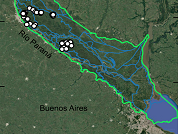Nutrient limitation in the Lower Paraná River floodplain: leaf nitrogen and phosphorus analyses in macrophytes
DOI:
https://doi.org/10.14522/darwiniana.2023.111.1100Keywords:
Ecological stoichiometry, fluvial wetlands, leaf nutrients, macrophytes, nutrient limitation, Paraná River DeltaAbstract
Nitrogen (N) and phosphorus (P) are the most limiting nutrients in natural freshwater wetlands. Flooded marshes dominate in the freshwater wetlands of the Lower Paraná River floodplain (Argentina). The leaf N and P concentration and the N:P ratios were assessed as a first approach to evaluate the nature of nutrient limitation. A total of 96 sites and 131 dominant plant populations (belonging to 50 herbaceous macrophyte species) were sampled in medium hydrometric level conditions. The interspecific variability of leaf nutrients was higher than the intraspecific variability. Foliar N ranged from 0.5% to 5.3%, while foliar P ranged from 0.1% to 0.5%. Leaf N:P was 9.3 ± 4.3 (mean ± standard deviation), suggesting N-limitation for most of the plant populations –under the assumption of the validity of the critical N:P thresholds previously proposed (N:P < 10 for N limitation, N:P > 20 for P limitation). Neither the leaf nutrients nor the N:P were affected by the flooding frequency, hydrometric water level, or wetland landscape unit/subunit location. The species identity accounted for most of the leaf nutrient and N:P variability, followed by the sampling date for P and N:P levels. This study provides a baseline on the nature of nutrient limitation, mainly by N, in plants of the Lower Paraná River floodplain. Future surveys or experiments could address the variations of leaf nutrients and nutrient limitation in contrasting hydrological conditions.

Downloads
Published
How to Cite
Issue
Section
License

Starting on 2012, Darwiniana Nueva Serie uses Licencia Creative Commons Atribución-NoComercial 2.5 Argentina .





